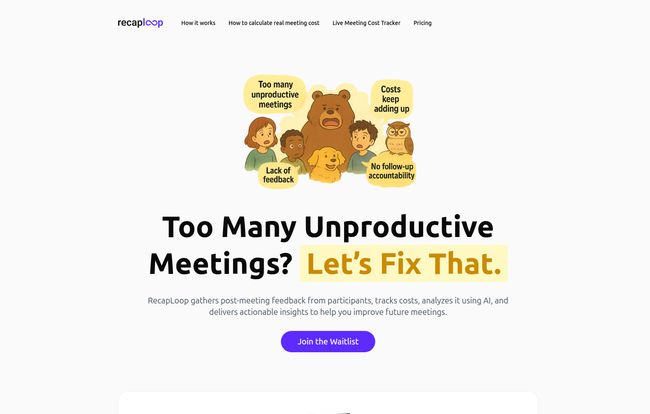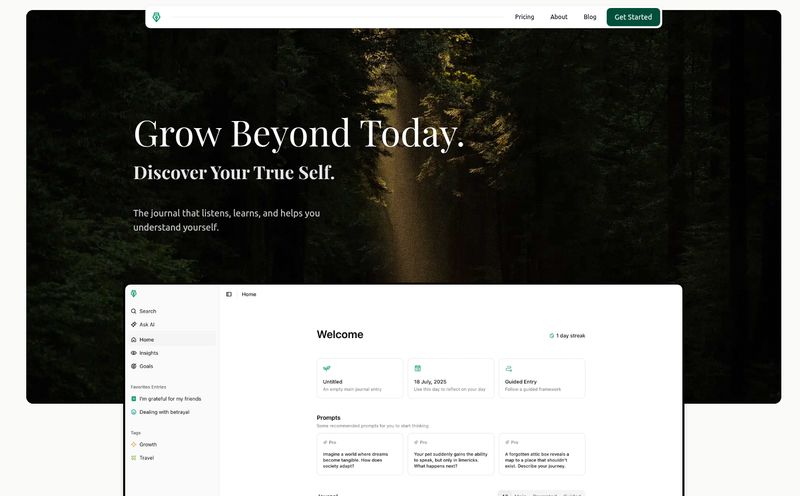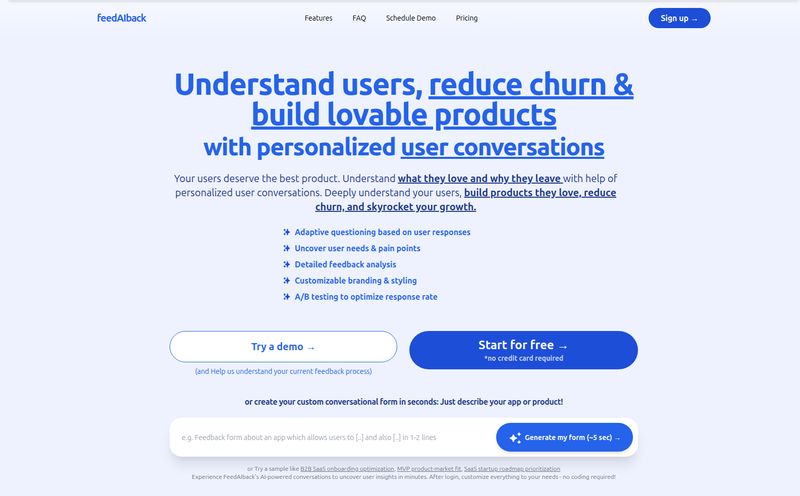You know the feeling. It’s 2:57 PM. You’re in the zone, finally crushing that to-do list, and then… ding. The 15-minute reminder for that one-hour “Weekly Sync” that you know, deep in your soul, could have been an email. A little piece of your productivity dies. We’ve all been there, staring at the ceiling in a conference room (or, more likely these days, at our own faces on Zoom), wondering how much of our lives are spent in these weird, unproductive time-sucks.
It’s a massive problem. I saw a stat on RecapLoop’s site that the average worker spends 31 hours per month in unproductive meetings. Thirty. One. Hours. At an average of $15/hour, that’s nearly $500 flushed down the drain. Per person. Every single month. When I first read that, I wasn’t even surprised. I just nodded sadly. It feels true, doesn't it?
For years, we’ve just accepted it as the cost of doing business. But what if we could actually diagnose the problem? What if we could put our meetings under a microscope and figure out which ones are valuable and which are just expensive habits? A new tool called RecapLoop is stepping into the ring, and I’ve got to say, I'm intrigued.
So, What Exactly Is RecapLoop?
In the simplest terms, I'd call RecapLoop a Fitbit for your meetings. It’s not another complex project management suite or a new calendar app. Instead, it hooks into what you already use (hello, Google Calendar) and works quietly in the background to figure out one thing: was that meeting actually worth it?
The whole process is refreshingly simple. After a meeting ends, RecapLoop automatically sends a little recap to all the participants, either through Slack or email. This isn't a long, boring survey. It's usually just a quick, one-click rating system—think smiley faces. Participants can also leave short, anonymous comments if they feel like it.
And this is where the magic happens. RecapLoop takes all that feedback, mashes it together with the meeting’s duration and the number of attendees (and their approximate cost), and feeds it to its AI brain. What comes out the other side isn't just a pile of data, but actual insights. You get a clear dashboard showing which meetings are hitting the mark and which are consistently getting a thumbs-down. It’s like turning the lights on in a room you didn’t even know was dark.
The Features That Genuinely Caught My Eye
Look, I’ve seen a million productivity apps. Most of them promise to change your life and end up being just another notification to ignore. But a few things about RecapLoop feel different and, dare I say, actually useful.
Finally, a Meeting Cost Calculator That Makes Sense
We all know meetings are expensive, but it’s always been this vague, abstract concept. RecapLoop makes it painfully, beautifully concrete. Seeing a chart that says, “Your weekly development sync cost the company $980 this month and has an average rating of 2.1 out of 5” is… powerful. It’s not about shaming people; it's about providing the objective data needed to ask, “Okay, how can we make this sync better? Or should it be shorter? Or maybe it should just be an email?”
AI-Powered Insights, Not Just More Data
Collecting data is easy. Making sense of it is hard. The AI analysis is the core of what makes this tool interesting. It can spot trends you’d never see on your own. For example, the image on their site shows feedback like, “The meeting on expected new laws… but it lacked depth in some areas.” That’s a goldmine. It tells a manager not to cancel the meeting, but to come better prepared next time. It helps distinguish between a meeting that was a bad idea and a meeting that was just poorly executed. That's a huge difference.

Visit RecapLoop
Frictionless Feedback Through Slack and Email
The biggest hurdle for any feedback system is getting people to actually use it. If you send me a link to a 10-question SurveyMonkey form, I am not filling that out. I’m just not. RecapLoop’s approach of sending a quick-tap rating via Slack or email is smart. It meets people where they already are and asks for a tiny, two-second commitment. That’s how you get real, consistent participation.
My Honest Take: The Good and The Could-Be-Better
Alright, let’s get down to it. No tool is perfect, especially one that’s just getting started (it’s currently on a waitlist, which is important to know). From my perspective as someone who lives and breathes digital efficiency, here’s how I see it.
What I Really Like
The core concept is brilliant because it’s so simple. It automates feedback collection, which nobody has time for, and it ties that qualitative feedback directly to a quantitative metric: cost. This data-driven approach is what separates it from just complaining about meetings in a private Slack channel. It gives teams a common language and objective numbers to discuss what’s working and what isn’t. For any manager trying to foster a better company culture around meetings, this feels like a cheat code. It’s easy to implement and integrates with the tools we’re all stuck with anyway.
A Few Caveats
Of course, there are potential hiccups. The system’s value is directly tied to the quality of participant feedback. If your team just clicks the happy face on every meeting to get the notification to go away, you’re not going to get much value. It requires a little bit of buy-in. Also, AI is not magic. It's pattern recognition. It might occasionally misinterpret a sarcastic comment or fail to grasp the full context of a project. And like any new tool, there's an initial setup, though it seems pretty minimal. The basic plan has a few limitations, but for the price, it seems more than fair.
Let's Talk Money: RecapLoop Pricing
The pricing structure is refreshingly straightforward, which I always appreciate. No confusing tiers with hidden features. It’s simple.
| Plan | Price | Best For |
|---|---|---|
| Basic Plan | $20 /month | Individuals and small teams (Pay as you go) |
| Pro Plan | $199 /yearly | Larger teams wanting an annual plan |
Both plans seem to offer the exact same feature set: event recaps, unlimited members, Google Calendar integration, AI analysis, data exports, and the cost overview. The only real difference is the billing cycle. For $20 a month, you can get a real-time pulse on your team’s most expensive activity. To me, if it helps you cut just one unnecessary hour-long meeting for a team of five, it has already paid for itself several times over. That’s a pretty compelling ROI.
Who Is This Tool Actually For?
I don’t think this is for everyone. If you’re a solo freelancer, you probably don’t need it. But if you’re a team lead, a department manager, an HR professional, or a C-suite executive in a company with more than a handful of people, this should be on your radar.
It’s especially powerful for remote or hybrid companies. In an office, you can sometimes get a feel for a meeting’s vibe from body language. Online, everyone is just a box on a screen. You lose that informal feedback loop. RecapLoop essentially rebuilds that loop with data, which is perfect for the modern, distributed workforce.
Is It Time to Get in the Loop?
I've always believed you can't improve what you don't measure. For decades, meetings have been a measurement-free zone—a black hole of time and money we just accepted. RecapLoop feels like one of the first tools I've seen that tries to bring some real, honest-to-goodness accountability to the calendar.
It won't magically solve all your problems. It won't write your meeting agendas or make difficult conversations any easier. But it will give you a diagnosis. It will show you where the bleeding is, and that’s the first step toward stopping it. Since it's currently on a waitlist, there’s no harm in signing up to be notified. If you're tired of the meeting madness, this might just be the loop you've been waiting for.
Frequently Asked Questions
- How does RecapLoop calculate the cost of a meeting?
- It typically works by allowing an administrator to set an average hourly cost for employees. It then multiplies that cost by the number of attendees and the duration of the meeting. This gives you a solid, data-backed estimate of the meeting's expense.
- Is the feedback my team provides anonymous?
- While not explicitly stated, feedback tools like this are most effective when feedback is anonymized. This encourages honest responses without fear of reprisal. It's likely that individual ratings and comments are aggregated and presented without names attached.
- What calendars does RecapLoop integrate with?
- According to their website, it currently integrates with Google Calendar. Integrations with other calendar systems like Outlook would be a logical next step as they grow.
- Can I start using RecapLoop right now?
- Not quite. As of this writing, RecapLoop is in a pre-launch phase. You can visit their website to join a waitlist and be notified when the platform goes live.
- How is this different from just sending out a Google Form or survey?
- The main differences are automation and integration. RecapLoop automatically triggers after every event and injects the request directly into workflows (Slack/Email). It also handles the cost calculation and AI-powered trend analysis, which a simple survey tool can't do without significant manual work.
Reference and Sources
- RecapLoop Official Website: https://www.recaploop.com
- RecapLoop Pricing Page: https://www.recaploop.com/pricing



